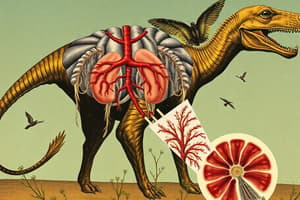Podcast
Questions and Answers
Which of the following is true about vasodilation in thermoregulation?
Which of the following is true about vasodilation in thermoregulation?
- Vasodilation reduces heat loss by widening superficial blood vessels.
- Vasodilation decreases heat loss by widening superficial blood vessels.
- Vasodilation promotes heat loss by narrowing superficial blood vessels.
- Vasodilation increases heat loss by narrowing superficial blood vessels. (correct)
What is the main purpose of vasoconstriction in thermoregulation?
What is the main purpose of vasoconstriction in thermoregulation?
- To increase heat loss by narrowing superficial blood vessels.
- To promote heat loss by widening superficial blood vessels.
- To decrease heat loss by widening superficial blood vessels.
- To reduce heat loss by narrowing superficial blood vessels. (correct)
In many birds and mammals, what is the mechanism used to reduce heat loss from the body?
In many birds and mammals, what is the mechanism used to reduce heat loss from the body?
- Countercurrent exchange (correct)
- Vasodilation
- Thermogenesis
- Vasoconstriction
Which of the following statements about countercurrent exchange is true?
Which of the following statements about countercurrent exchange is true?
What happens to arterial blood as it gets closer to the extremities of an animal?
What happens to arterial blood as it gets closer to the extremities of an animal?
Which of the following is NOT a circulatory adaptation for thermoregulation?
Which of the following is NOT a circulatory adaptation for thermoregulation?
What is the purpose of countercurrent exchange in thermoregulation?
What is the purpose of countercurrent exchange in thermoregulation?
Which of the following is true about the relationship between arteries and veins in countercurrent exchange?
Which of the following is true about the relationship between arteries and veins in countercurrent exchange?
Which of the following statements is true about the blood flow between the body core and surface in response to changes in environmental temperature?
Which of the following statements is true about the blood flow between the body core and surface in response to changes in environmental temperature?
What is the main purpose of vasoconstriction in thermoregulation?
What is the main purpose of vasoconstriction in thermoregulation?
Which of the following is a characteristic of acclimatization in birds and mammals?
Which of the following is a characteristic of acclimatization in birds and mammals?
What is the function of the hypothalamus in mammalian thermoregulation?
What is the function of the hypothalamus in mammalian thermoregulation?
What is the purpose of producing 'antifreeze' compounds in some ectotherms?
What is the purpose of producing 'antifreeze' compounds in some ectotherms?
What is the general term for the processes by which animals control solute concentrations and balance water gain and loss?
What is the general term for the processes by which animals control solute concentrations and balance water gain and loss?
What is the main role of the hypothalamus in human thermoregulation?
What is the main role of the hypothalamus in human thermoregulation?
What is the purpose of excretion in animals?
What is the purpose of excretion in animals?
What controls thermoregulation in mammals?
What controls thermoregulation in mammals?
What is the purpose of adjusting insulation in birds and mammals?
What is the purpose of adjusting insulation in birds and mammals?
What are some examples of mechanisms for excretion in animals?
What are some examples of mechanisms for excretion in animals?
What is the purpose of producing 'antifreeze' compounds in some ectotherms?
What is the purpose of producing 'antifreeze' compounds in some ectotherms?
Flashcards are hidden until you start studying




